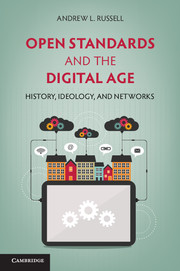Book contents
- Frontmatter
- Dedication
- Contents
- Tables and Figures
- Acknowledgments
- List of acronyms
- 1 Introduction
- 2 Ideological Origins of Open Standards I: Telegraph and Engineering Standards, 1860s–1900s
- 3 Ideological Origins of Open Standards II: American Standards, 1910s–1930s
- 4 Standardization and the Monopoly Bell System, 1880s–1930s
- 5 Critiques of Centralized Control, 1930s–1970s
- 6 International Standards for the Convergence of Computers and Communications, 1960s–1970s
- 7 Open Systems and the Limits of Democratic Design, 1970s–1980s
- 8 The Internet and the Advantages of Autocratic Design, 1970s–1990s
- 9 Conclusion
- Bibliography
- Index
- References
7 - Open Systems and the Limits of Democratic Design, 1970s–1980s
Published online by Cambridge University Press: 05 June 2014
- Frontmatter
- Dedication
- Contents
- Tables and Figures
- Acknowledgments
- List of acronyms
- 1 Introduction
- 2 Ideological Origins of Open Standards I: Telegraph and Engineering Standards, 1860s–1900s
- 3 Ideological Origins of Open Standards II: American Standards, 1910s–1930s
- 4 Standardization and the Monopoly Bell System, 1880s–1930s
- 5 Critiques of Centralized Control, 1930s–1970s
- 6 International Standards for the Convergence of Computers and Communications, 1960s–1970s
- 7 Open Systems and the Limits of Democratic Design, 1970s–1980s
- 8 The Internet and the Advantages of Autocratic Design, 1970s–1990s
- 9 Conclusion
- Bibliography
- Index
- References
Summary
Networks are political issues at government or corporate levels. In hush statements, communications and computer organizations leak their feelings that the other guys had better mind their own business. Since they are big, and more or less monopolies, each scrambles at shaping the world into specific designs before the others do it. Lost in the turmoil is the user. He has no strategy, no power. He thinks the big brothers know what they’re doing. No doubt, there are some who do. Take for example our beloved friend IBM.
– Louis Pouzin, “The Communications Network Snarl,” 1975The promise of data networking was evident to everyone who worked near the intersections of digital computer and communication technologies. The Bell Labs economist Jeffrey Rohlfs articulated the new conventional wisdom in a pioneering 1974 article, in which he based his “theory of interdependent demand for a communications service” on a forceful assertion: “The utility that a subscriber derives from a communication service increases as others join the system.” Rohlfs theorized and mathematized the lessons that the packet-switching researchers we met in Chapter 6 – such as Louis Pouzin, Vinton Cerf, Robert Kahn, Rémi Déspres, and Marc Levilion – understood intuitively: the value of a digital computer-communication network would reside primarily in its ability to facilitate and sustain interconnections on an ever-increasing scale.
As we have seen, these packet-switching researchers gained firsthand experience with the obstacles that prevented the universal adoption of new standards for data networking. As the “virtual circuit versus datagram” controversy described in Chapter 6 demonstrated, many technical disagreements mapped directly to conflicting strategic priorities and conflicting visions of control: telecommunications engineers used virtual circuits to keep more control inside the network, but computer engineers favored connectionless datagrams to shift control to the computers at the edges of the network. As positions hardened in the mid-1970s and it became clear that the argument was unlikely to be settled on technical merits alone, the network engineers we will meet in this chapter sought to create effective alliances that could constrain and direct the creation of international networking standards.
- Type
- Chapter
- Information
- Open Standards and the Digital AgeHistory, Ideology, and Networks, pp. 197 - 228Publisher: Cambridge University PressPrint publication year: 2014



